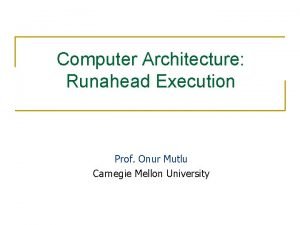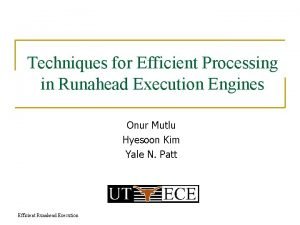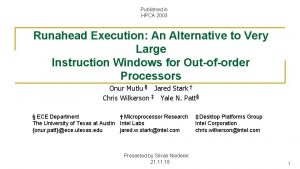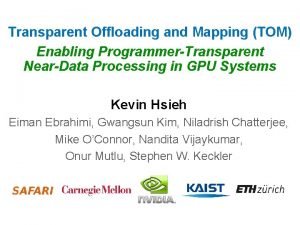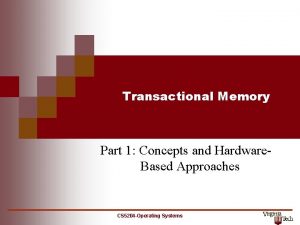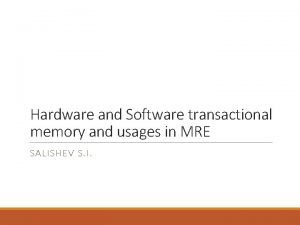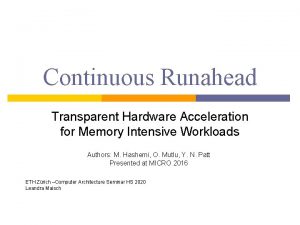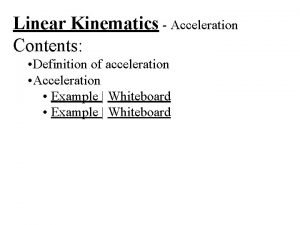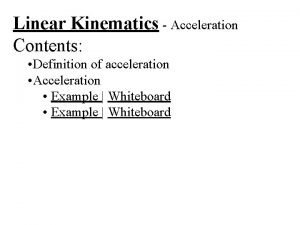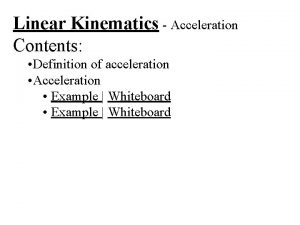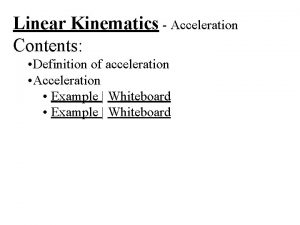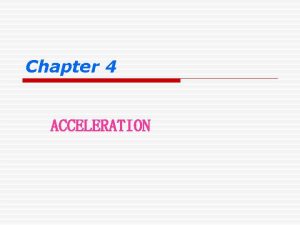Continuous Runahead Transparent Hardware Acceleration for Memory Intensive













![14 Dependence Chains LD [R 3] -> R 5 ADD R 4, R 5 14 Dependence Chains LD [R 3] -> R 5 ADD R 4, R 5](https://slidetodoc.com/presentation_image_h/37ff1f566b5e4c08029a387541137946/image-14.jpg)






























- Slides: 44

Continuous Runahead: Transparent Hardware Acceleration for Memory Intensive Workloads Milad Hashemi, Onur Mutlu, Yale N. Patt UT Austin/Google, ETH Zürich, UT Austin October 19 th, 2016

2 Continuous Runahead Outline • • • Overview of Runahead Limitations Continuous Runahead Dependence Chains Continuous Runahead Engine Continuous Runahead Evaluation Conclusions

3 Continuous Runahead Outline • • • Overview of Runahead Limitations Continuous Runahead Dependence Chains Continuous Runahead Engine Continuous Runahead Evaluation Conclusions

4 Runahead Execution Overview • Runahead dynamically expands the instruction window when the pipeline is stalled [Mutlu et al. , 2003] • The core checkpoints architectural state • The result of the memory operation that caused the stall is marked as poisoned in the physical register file • The core continues to fetch and execute instructions • Operations are discarded instead of retired • The goal is to generate new independent cache misses

5 100% 90% 80% 70% 60% 50% 40% 30% 20% 10% 0% Runahead GHB Stream ea n M m cf m lb an tu m es qu av lib bw nx hi sp ex ilc m pl so om ne tp p sli e le m s. F DT D rf w Ge us ca ct us m p Markov + Stream ze Request Accuracy Traditional Runahead Accuracy

6 100% 90% 80% 70% 60% 50% 40% 30% 20% 10% 0% Runahead is 95% Accurate Runahead GHB Stream ea n M m cf m lb an tu m es qu av lib bw nx hi sp ex ilc m pl so om ne tp p sli e le m s. F DT D rf w Ge us ca ct us m p Markov + Stream ze Request Accuracy Traditional Runahead Accuracy

lib qu m ea n M m cf lb an tu m es av bw ex nx hi sp pl so p ilc m tp ne om sli e le D rf DT m s. F Ge w us ca ct p m us ze % Independent Cache Misses 7 Traditional Runahead Prefetch Coverage 100% 90% 80% 70% 60% 50% 40% 30% 20% 10% 0%

8 100% 90% 80% 70% 60% 50% 40% 30% 20% 10% 0% lib qu ea n M m cf m lb an tu m es av bw nx hi sp ex pl so ilc m ne tp p sli e om m s. F Ge le DT D rf w us ca ct us m p Runahead has only 13% Prefetch Coverage ze % Independent Cache Misses Traditional Runahead Prefetch Coverage

Runahead Performance Gain lib qu Oracle Performance Gain m ea n M m cf lb an tu m es av bw ex nx hi sp pl so ilc m p tp ne om sli e le D rf DT m s. F Ge w us ca ct p m us ze % IPC Improvement over No-Prefetching Baseline 9 Traditional Runahead Performance Gain 350% 300% 250% 200% 150% 100% 50% 0%

10 Traditional Runahead Performance Gain 300% 250% 200% Runahead has a 12% Performance Gain Runahead Oracle has an 85% Performance Gain 150% 100% 50% Runahead Performance Gain lib qu Oracle Performance Gain ea n M m cf m lb an tu m es av bw nx hi sp ex pl so ilc m ne tp p sli e om m s. F Ge le DT D rf w us ca ct us m p 0% ze % IPC Improvement over No-Prefetching Baseline 350%

lib qu ea n M m cf m lb um an t es av bw ex nx hi sp pl so p ilc m tp sli e le ne om rf DT D m s. F Ge w us ca ct p m us ze Cycles Per Runahead Interval 11 Traditional Runahead Interval Length 140 120 100 80 60 128 ROB 256 ROB 40 512 ROB 20 1024 ROB 0

12 Traditional Runahead Interval Length 120 100 80 128 ROB 60 Runahead Intervals are Short Low Performance Gain 256 ROB 40 512 ROB 20 1024 ROB qu ea n M m cf m lb an t um es lib bw nx hi sp ex pl so ilc m p tp ne le sli e om Ge m s. F DT D rf w us ca ct ze us m p 0 av Cycles Per Runahead Interval 140

13 Continuous Runahead Challenges • Which instructions to use during Continuous Runahead? • Dynamically target the dependence chains that lead to critical cache misses • What hardware to use for Continuous Runahead? • How long should chains pre-execute for?
![14 Dependence Chains LD R 3 R 5 ADD R 4 R 5 14 Dependence Chains LD [R 3] -> R 5 ADD R 4, R 5](https://slidetodoc.com/presentation_image_h/37ff1f566b5e4c08029a387541137946/image-14.jpg)
14 Dependence Chains LD [R 3] -> R 5 ADD R 4, R 5 -> R 9 ADD R 9, R 1 -> R 6 LD [R 6] -> R 8 Cache Miss

15 Dependence Chain Selection Policies Experiment with 3 policies to determine the best policy to use for Continuous Runahead: • PC-Based Policy • Use the dependence chain that has caused the most misses for the PC that is blocking retirement • Maximum Misses Policy • Use a dependence chain from the PC that has generated the most misses for the application • Stall Policy • Use a dependence chain from the PC that has caused the most fullwindow stalls for the application

16 Dependence Chain Selection Policies 100 60 Runahead Buffer PC-Policy 40 Maximum-Misses Policy 20 Stall Policy m cf M ea n m lb an tu m es qu av lib bw nx sp hi ex pl m ilc so om ne tp p sli e le rf m s. F DT D w Ge us ca ct us -20 m p 0 ze % IPC Improvement 80

17 1000 900 800 700 600 500 400 300 200 100 0 90% of Stalls All Stalls lib qu ea n M m cf m lb an tu m es av bw nx hi sp ex ilc m pl so om ne tp p sli e le rf Ge m s. F DT D w us ca ct us m p All Misses ze Number of PCs Why does Stall Policy Work?

18 1000 900 800 700 600 500 400 300 200 100 0 19 PCs cover 90% of all Stalls 90% of Stalls All Stalls lib qu ea n M m cf m lb an tu m es av bw nx hi sp ex ilc m pl so om ne tp p sli e le rf Ge m s. F DT D w us ca ct us m p All Misses ze Number of PCs Why does Stall Policy Work?

19 Constrained Dependence Chain Storage 1 0. 8 1 Chain 2 Chains 0. 6 4 Chains 0. 4 8 Chains 16 Chains 0. 2 32 Chains lib qu ea n M m cf m lb an t um es av bw nx hi sp ex ilc m pl so om ne tp p sli e le w rf Ge m s. F DT D us ca ct us m p 0 ze Normalized Performance 1. 2

20 Constrained Dependence Chain Storage 1 0. 8 1 Chain Storing 1 Chain provides 95% of the Performance 0. 6 0. 4 2 Chains 4 Chains 8 Chains 16 Chains 0. 2 32 Chains lib qu ea n M m cf m lb an t um es av bw nx hi sp ex ilc m pl so om ne tp p sli e le w rf Ge m s. F DT D us ca ct us m p 0 ze Normalized Performance 1. 2

21 Continuous Runahead Chain Generation Maintain two structures: • 32 -entry cache of PCs to track the operations that cause the pipeline to frequently stall • The last dependence chain for the PC that has caused the most full-window stalls At every full window stall: • Increment the counter of the PC that caused the stall • Generate a dependence chain for the PC that has caused the most stalls

22 Runahead for Longer Intervals

23 CRE Microarchitecture • • • No Front-End No Register Renaming Hardware 32 Physical Registers 2 -Wide No Floating Point or Vector Pipeline 4 k. B Data Cache

24 Dependence Chain Generation Cycle: 0 14253 ADD P 7 + 1 -> P 1 ADD E 5 + 1 -> E 3 SHIFT P 1 -> P 9 SHIFT E 3 -> E 4 Register Remapping Table: ADD P 9 + P 1 -> P 3 ADD E 4 + E 3 -> E 2 Search List: P 7 P 9, P 1 P 3 P 2 P 1 EAX EBX ECX Core Physical Register P 1 P 7 P 8 P 3 P 2 P 9 SHIFT P 3 -> P 2 SHIFT E 2 -> E 1 CRE Physical Register E 3 E 5 E 0 E 2 E 1 E 4 LD [P 2] -> P 8 LD [E 1] -> E 0 First CRE Physical Register E 3 E 0 E 1 MAP E 3 -> E 5

25 Dependence Chain Generation

26 Interval Length 100% 90% 80% 70% 60% 50% 40% 30% 20% 10% 0% Continuous Runahead Request Accuracy GMean Performance Gain 1 k 5 k 10 k 25 k 50 k 100 k 250 k 500 k Update Interval (Instructions Retired) 1 M 2 M

27 System Configuration • Single-Core/Quad-Core • 4 -wide Issue • 256 Entry Reorder Buffer • 92 Entry Reservation Station • Caches • Prefetchers • Stream, Global History Buffer • Feedback Directed Prefetching: Dynamic Degree 1 -32 • CRE Compute • 2 -wide issue • 1 Continuous Runahead issue context with a 32 -entry buffer and • Non-Uniform Memory Access Latency 32 -entry physical register file DDR 3 System • 4 k. B Data Cache • 256 -Entry Memory Queue • 32 KB 8 -Way Set Associative L 1 I/D-Cache • 1 MB 8 -Way Set Associative Shared Last Level Cache per Core • Batch Scheduling

lib m lb um an t es m cf GM ea n qu av bw ex nx hi sp pl so p ilc m tp ne om sli e le Ge wrf m s. F DT D us ca ct m p us ze % IPC Improvement over No-Prefetching Baseline 28 Single-Core Performance 120 100 80 60 40 Runahead Buffer Continuous Runahead 20 0

29 Single-Core Performance 100 80 21% Single Core Performance Increase Runahead Buffer over prior State of the Art Continuous Runahead 60 40 20 m cf GM ea n m lb um an t es qu av lib bw nx sp hi ex pl m ilc so om ne tp p sli e le Ge wrf m s. F DT D us ca ct us m p 0 ze % IPC Improvement over No-Prefetching Baseline 120

30 Single-Core Performance + Prefetching 120 100 Runahead Buffer 80 Continuous Runahead 60 Stream PF 40 GHB PF 20 Continuous Runahead + Stream Continuous Runahead + GHB m c GM f ea n m lb um an t es qu lib bw av nx sp hi ex so pl ilc m m rf s. F DT D le s om lie ne tp p w Ge us ca ct us m p 0 ze % IPC Improvement over No-Prefetching Baseline 140

31 Single-Core Performance + Prefetching 120 100 Runahead Buffer 80 Continuous Runahead Increases Performance over and Stream PF In-Conjunction with Prefetching GHB PF 60 40 Continuous Runahead + Stream 20 Continuous Runahead + GHB m c GM f ea n m lb um an t es qu lib bw av nx sp hi ex so pl ilc m m rf s. F DT D le s om lie ne tp p w Ge us ca ct us m p 0 ze % IPC Improvement over No-Prefetching Baseline 140

qu lib ea n M m cf m lb an tu m es av bw ex nx hi sp pl so p ilc m tp ne om sli e le rf Ge m s. F DT D w us ca ct p m us ze % Independent Cache Misses Prefetched 32 Independent Miss Coverage 100% 90% 80% 70% 60% 50% 40% 30% 20% 10% 0%

qu lib ea n M m cf m lb an tu m es av bw ex nx hi sp pl so p ilc m tp ne om sli e 100% 90% 80% 70% 60% 50% 40% 30% 20% 10% 0% le rf Ge m s. F DT D w us ca ct p m us ze % Independent Cache Misses Prefetched 33 Independent Miss Coverage 70% Prefetch Coverage

qu lib m ea n M m cf lb an tu m es av bw ex nx hi sp pl so p ilc m tp ne om sli e le Ge wrf m s. F DT D us ca ct p m us ze Normalized Bandwidth 34 Bandwidth Overhead 2. 5 2 1. 5 1 Continuous Runahead Stream PF 0. 5 GHB PF 0

qu lib m ea n M m cf lb an tu m es av bw ex nx hi sp pl so p ilc m tp ne om 1 sli e 1. 5 le Ge wrf m s. F DT D us ca ct p m us ze Normalized Bandwidth 35 Bandwidth Overhead 2. 5 2 Low Bandwidth Overhead Continuous Runahead Stream PF 0. 5 GHB PF 0

36 Multi-Core Performance % Weighted Speedup Improvement 60 50 40 Continuous Runahead 30 Stream PF GHB PF 20 10 0 H 1 H 2 H 3 H 4 H 5 H 6 H 7 H 8 H 9 H 10 GMean

37 Multi-Core Performance % Weighted Speedup Improvement 60 50 40 43% Weighted Speedup Increase 30 Stream PF GHB PF 20 10 0 Continuous Runahead H 1 H 2 H 3 H 4 H 5 H 6 H 7 H 8 H 9 H 10 GMean

38 Multi-Core Performance + Prefetching % Weighted Speedup Improvement 90 80 70 60 Continuous Runahead 50 Stream PF 40 GHB PF Continuous Runahead + Stream 30 Continuous Runahead + GHB 20 10 0 H 1 H 2 H 3 H 4 H 5 H 6 H 7 H 8 H 9 H 10 GMean

39 Multi-Core Performance + Prefetching % Weighted Speedup Improvement 90 80 70 60 13% Weighted Speedup Gain over Stream PF GHB Prefetching Continuous Runahead + Stream Continuous Runahead 50 40 30 Continuous Runahead + GHB 20 10 0 H 1 H 2 H 3 H 4 H 5 H 6 H 7 H 8 H 9 H 10 GMean

40 Multi-Core Energy Evaluation 1 Energy Normalized to No-Prefetching Baseline 0. 9 0. 8 0. 7 Continuous Runahead 0. 6 Stream PF 0. 5 GHB PF 0. 4 Continuous Runahead + Stream 0. 3 Continuous Runahead + GHB 0. 2 0. 1 0 H 1 H 2 H 3 H 4 H 5 H 6 H 7 H 8 H 9 H 10 Mean

41 Multi-Core Energy Evaluation 1 Energy Normalized to No-Prefetching Baseline 0. 9 0. 8 0. 7 22% Energy Reduction 0. 6 0. 5 Stream PF GHB PF 0. 4 Continuous Runahead + Stream 0. 3 Continuous Runahead + GHB 0. 2 0. 1 0 Continuous Runahead H 1 H 2 H 3 H 4 H 5 H 6 H 7 H 8 H 9 H 10 Mean

42 Conclusions • Runahead prefetch coverage is limited by the duration of each runahead interval • To remove this constraint, we introduce the notion of Continuous Runahead • We can dynamically identify the most critical LLC misses to target with Continuous Runahead by tracking the operations that cause the pipeline to frequently stall • We migrate these dependence chains to the CRE where they are executed continuously in a loop

43 Conclusions • Continuous Runahead greatly increases prefetch coverage • Increases single-core performance by 34. 4% • Increases multi-core performance by 43. 3% • Synergistic with various types of prefetching

Continuous Runahead: Transparent Hardware Acceleration for Memory Intensive Workloads Milad Hashemi, Onur Mutlu, Yale N. Patt UT Austin/Google, ETH Zürich, UT Austin October 19 th, 2016
 Runahead execution
Runahead execution Runahead execution
Runahead execution Runahead execution
Runahead execution Tmo: transparent memory offloading in datacenters
Tmo: transparent memory offloading in datacenters Solar eclipse accel
Solar eclipse accel Relation between linear and angular quantities
Relation between linear and angular quantities Is radial acceleration the same as centripetal acceleration
Is radial acceleration the same as centripetal acceleration Kinetic angular energy
Kinetic angular energy Centripetal acceleration tangential acceleration
Centripetal acceleration tangential acceleration What is internal hardware
What is internal hardware Present continuous past continuous
Present continuous past continuous Present simple past simple future simple
Present simple past simple future simple Hardware transactional memory
Hardware transactional memory Transactional memory
Transactional memory Restricted transactional memory
Restricted transactional memory Prototypes in semantics
Prototypes in semantics Implicit explicit memory
Implicit explicit memory Long term memory vs short term memory
Long term memory vs short term memory Internal memory and external memory
Internal memory and external memory Primary memory and secondary memory
Primary memory and secondary memory Logical and physical address in os
Logical and physical address in os Which memory is the actual working memory?
Which memory is the actual working memory? Virtual memory and cache memory
Virtual memory and cache memory Virtual memory in memory hierarchy consists of
Virtual memory in memory hierarchy consists of Eidetic memory vs iconic memory
Eidetic memory vs iconic memory Shared memory vs distributed memory
Shared memory vs distributed memory Iso 22301 utbildning
Iso 22301 utbildning Typiska novell drag
Typiska novell drag Nationell inriktning för artificiell intelligens
Nationell inriktning för artificiell intelligens Vad står k.r.å.k.a.n för
Vad står k.r.å.k.a.n för Shingelfrisyren
Shingelfrisyren En lathund för arbete med kontinuitetshantering
En lathund för arbete med kontinuitetshantering Kassaregister ideell förening
Kassaregister ideell förening Tidböcker
Tidböcker Anatomi organ reproduksi
Anatomi organ reproduksi Densitet vatten
Densitet vatten Datorkunskap för nybörjare
Datorkunskap för nybörjare Tack för att ni lyssnade bild
Tack för att ni lyssnade bild Debattartikel mall
Debattartikel mall Delegerande ledarskap
Delegerande ledarskap Nyckelkompetenser för livslångt lärande
Nyckelkompetenser för livslångt lärande Påbyggnader för flakfordon
Påbyggnader för flakfordon Kraft per area
Kraft per area Svenskt ramverk för digital samverkan
Svenskt ramverk för digital samverkan Kyssande vind analys
Kyssande vind analys
